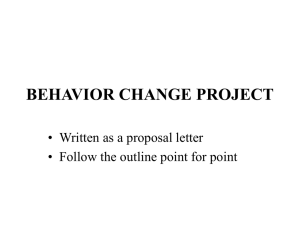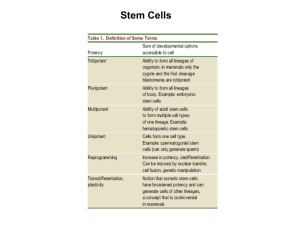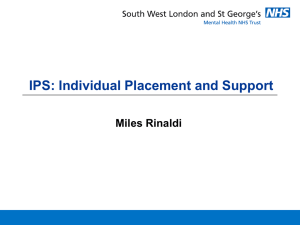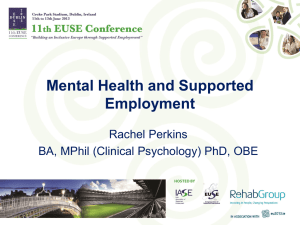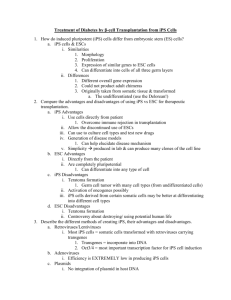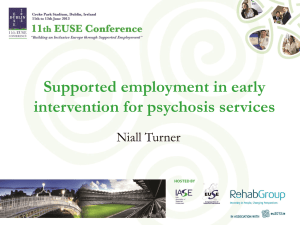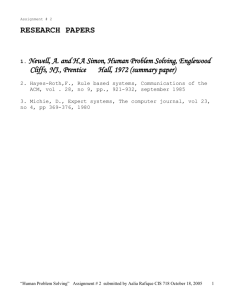NOT the word - Action Based Learning
advertisement
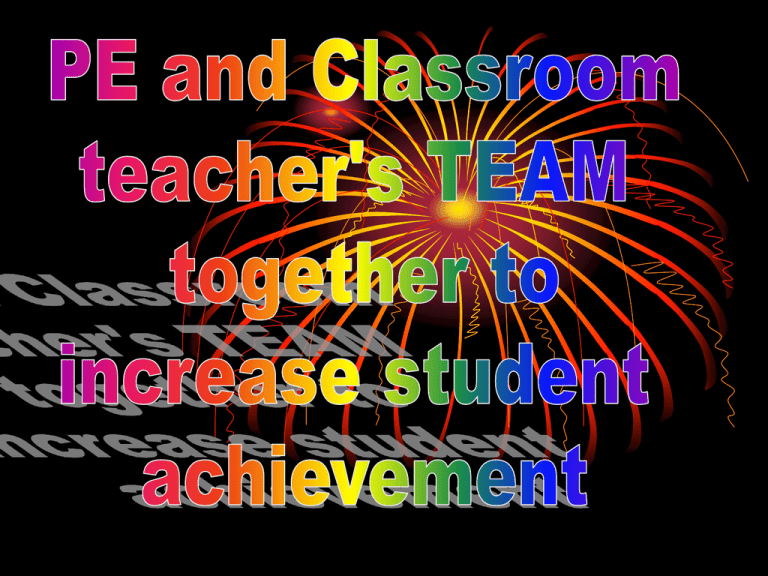
Kim Ward wardk@ips.k12.in.us Physical education/Wellness teacher and ABL specialist for IPS District Tracy Cutshaw CutshawT@ips.k12.in.us First Grade Teacher for IPS Audrey Satterblom satterba@ips.k12.in.us Wellness Director for IPS A Brain Teaser to wake us up and exercise the brain • Quick! say aloud what COLOR you see in every word, NOT the word you read. • Explanation: The Stroop test is used in neuropsychological evaluations to measure mental vitality and flexibility, since performing well requires strong attention and selfregulation capability. In 2004 IPS was awarded a PEP Grant In 2005 Professional development by Jean Blaydes Madigan In 2005 Kim, Tracy, Audrey, and a principal attend Cathie’s Summerford’s ACTION PACKED CLASSROOMS workshop In 2005 did a pilot study on ABL Engaging kids bodies and minds is more productive than delivering a non-interactive lecture to them; bringing movement into the classroom works! If you bring ENERGY and MOVEMENT into your classroom, your students will be MOTIVATED and able to RETAIN more information. Pilot study with Tracy’s Title One First grade classroom We used her DIBELS test as a pre-test. Tracy’s students came everyday to the gym during my lunch and prep to go through the lab. They did this everyday for 1 month. Tracy took her class through the lab herself. out of 16 were no longer on the retention list And • were longer low enough to get Title One services • At the end of the month…Tracy’s students were given a dibels assessment again. • The results were • An Action Based Learning specialist position was created for the District. • Kim Ward, physical education/wellness teacher gets 1 day off a week to devote to ABL. • IPS required all students K-6 to have 30 minutes of ABL in Summer School • Tracy and Kim did presentations for Summer School teachers Continued work with ABL ABL in Summer School continues • Research Study Does movement integrated with academics really make a difference? • Research under the direction of Lisa Hicks, Department Head of Kinesiology at University of Indianapolis • One 2nd grade classroom and one 3rd grade classroom used the lab 2-3 x’s a week. • The lab consisted of 7 stations • Each station had an academic component • The academic components were: Reading and spelling weekly test scores of both control and research classes End of 9 weeks grade in language arts and spelling for both control and research classes Semester grade for both control and research classes • Many IPS schools do not have an extra classroom to spare to set a lab up in anymore. • Gyms that were once open during lunch hours are now used for the large class loads we carry. • It takes extra time and effort to change the lab and add the academic components each week. • A Movement in the classroom cart was created. • It is now being used in 3 IPS schools • It contains the following equipment: • 6 inch balls scarves • Nylon rackets corelogs • Ribbons scooters • Poly spots balance boards • Fluffballs alphabet mat • Stepping stones http://abcnews.go.com/Video/play erIndex?id=7287548 Movement is especially good for: Kinesthetic learners 85% of school age children are kinesthetic learners. Our students struggle to sit still for long periods of time. Movement in the school day gives students an AVANTAGE for learning and therefore increases student achievement • Keeps kids FOCUSED • EXCITED • ENTHUIASTIC • And READY TO LEARN • By John Medina • EXERCISE | Rule #1: Exercise boosts brain power. • ATTENTION | Rule #4: We don't pay attention to boring things. • SHORT-TERM MEMORY | Rule #5: Repeat to remember. • As a rule, ADD ONE MINUTE to the average age of the children in class. This is about the length of time that those children can maintain concentration on a task. • Studies of the astronaut training programs indicate that daily exposure to spinning improves walking and motor skills. Students who participate in spinning routines show significant gains in attention span and reading. • • • • Seated spinning on a scooter Airplane spin on scooter Stand and spin in a hoop Hoppitty Hop spinning • Spinning stimulates the growth of myelin around the neurons, insulating them and allowing them to make more connections. • Blood flow is increased in all parts of the brain • This helps the brain by making it more alert and energized for learning. • Neural pathways are made stronger! • • • • • • Crosses or cross crawls Windmills Grapevine Straddle cross Hand clap patterns Jumping rope…is one of the best…both sides of the brain synchronize when jumping • Juggling • Ribbons or streamers • One of the reasons students have trouble reading is because of a lack of eye fitness. • Tracking exercises helps the eyes get fit to read. • Physical education provides an avenue for strengthening eye muscles making the eyes FIT to READ. • Stand about 10 feet from a wall You should be able to see all 4 corners by only moving your eyes • DVD of Tracy’s Classroom • 1. Have 1 student pick a card • 2. Student identifies the color on the card and the whole class does the activity that corresponds with that color. • 3. Do that activity for a certain amount of time (10-15 seconds) • Pick a new student • BLUE==Crosses • RED==Jump ropes • YELLOW==Spin 3 x’s to right and then 3x’s to the left • Green==scissor jumps • Each student will have an alphabet grid • Students will spell the word by doing cross-overs with their hands and touching the letters to spell the word. • When the letter is on the right side the student will use the left hand. 2. Students will do that activity until the music stops or the teacher says stop. 3. The teacher will then call out a spelling word and students will work together to spell the word correctly. Repeat Free time folder Movement song Get Funky The Alligator Chomp • Another benefit of adding movement to the classroom is for using it as an intervention. Students will partner up Teacher calls out a physical activity: Crosses Jumps (2 feet) Scissor jumps Jumping jacks Hopping (1 foot) Jogging in place How to get started: Do a presentation at a staff meeting of the importance of movement and how it stimulates the brain Give teachers movement ideas and brain breaks Make movement Cd’s for the classroom • www.jamschoolprogra m.com • 1. Face chair and tap toes • 2. Hands on hips, jump up and down • 3. Feet together, jump forward and backward • 4. Squat and stand • 5. Windmills •By weight, kiwifruit has more vitamin C than an orange and more potassium than a banana. • Video • We need to work together as a TEAM. • Physical educators can incorporate ACADEMICS AND BRAIN ACTIVITIES into some of our lessons AND Classroom teachers can incorporate MOVEMENT into their lesson plans. • Eric Jensen says: “It should be just as natural for a math teacher to use MOVEMENT in the classroom as for a physical educator to have students skip count.


